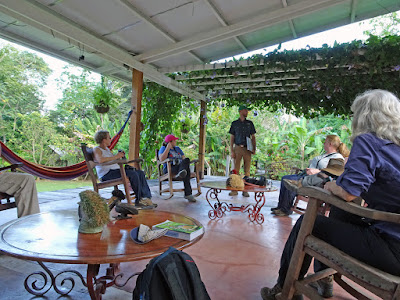Sunday 2/11/18 Continued.
As we entered the
Darien the roads vastly improved.
Since today was the start of Carnaval, we were stopped at about 15
police checkpoints since leaving Panama City this morning. I’m not sure what
they were looking for. Sometimes we were
detained while our driver got out and talked to the officers. Sometimes a few words were exchanged and we
were waved through. It certainly slowed
down the drive!
Carnival is an
official Panamanian holiday that consists of a five day celebration before Lent
begins on Ash Wednesday. Beginning the
weekend before Lent, Carnival is celebrated with parades, floats, costumes,
music and dancing in the streets.
December through February is summer in Panama and the schools are
out.
Darien is the largest of Panama’s 9 provinces. It has the largest tracts of primary forests,
the longest and widest rivers, the tallest trees. The Spanish founded the Darien in 1510, the
first settlement in the mainland of the New World and where Balboa discovered
el Mar del Sur (the Southern Sea), later called the Pacific Ocean.
It is in Darien where the Pan-American Highway (also called
Inter-American Highway) ends. It is the least inhabited province of
Panama, the least accessible, and the least known. Up until three years ago birding trips into the Darien were uncommon as few accommodations existed. With the construction of Canopy Camp birders now have a well-respected company to rely on in this area.
We finally made it to
Canopy Camp Darien. We have read a lot
about this place and saw plenty of pictures so we knew what to expect. What we didn’t expect was the heat. Highs in the mid-high 90’s, lows low-mid 70’s,
humidity 80+%.
The common area. This is the area we would gather before heading out or before meals. It is also the only area with Wi-Fi.
This dining area is where we had our meals.
This grassy area is between the common area and the dining area. There are some bird feeding stations at the back. Used by monkeys (Geoffroy’s Tamarins) more than birds!
The Manager, Dave, greeted us upon arrival. We were given our room numbers (Room #4 for us). Our luggage was sorted out and taken to our room while we had a short orientation from Dave about meal times, security, etc.
Dave welcoming us to Camp Darien.
Camp Darien features
eight large safari-style tents that are custom manufactured in Africa and are
designed specifically for use in environmentally sensitive areas. The tents are erected on raised platforms, to
keep you up off the ground and dry.
Up a short flight of stairs and onto our private deck.
There are six standard
suite tents and two deluxe suite tents.
We paid extra for a deluxe tent.
Our tent.
The two-room deluxe tents offer more space. 249
square feet, including an extra room for extra gear, two
tables, a floor fan and overhead light, and a solid teak wood floor.
Closet/dressing area. Note the beautiful teak floors
Each tent has a full private bathroom located directly
outside of the tent on the platform.
Short walkway to the bath (on the right).
Each bathroom has all the essentials – flush toilets and
a shower that offers serene, private views of the surrounding rain forest.
Inside the bathroom.
The hanging aluminum foil is used as a bat repellent.
Yes - the shower is outside!
The shower faced the forest and was very private.
Even though we did not have a lot of down time to relax, our very large private deck was a great place to view the jungle.
Our tent.
After checking out our tent and putting our things away everyone met back at the common area to do a little birding around the grounds.
We saw White-necked Jacobin, Bananaquit, Thick-billed Euphonia, Ruddy Ground-Dove, Chestnut-headed Oropendola, Tropical Kingbird, Giant Cowbird, White-headed Wren, Plain-colored Tanager, Sapphire-throated Hummingbird, and Orange-chinned Parakeet.
A Chestnut-headed Oropendola colony tree next to the common area provided plenty of opportunities to view these birds.
Oropendulas construct long hanging nests out at the tips of trees as a way to protect them from monkeys and other mammals. They also nest in colonies for additional protection.
Chestnut-headed Oropendola
Chestnut-headed Oropendola on nest
Parrots and Parakeets are common in the Darien. This Orange-chinned Parakeet was sitting quietly in a nearby tree while we received our orientation.
Orange-chinned Parakeet
We all went over the bird list for the day before dinner was served at 7:00 p.m.
Next time: Let the birding begin!
Teri

















Nice digs! You guys go to the most interesting places. Any non-birders there?
ReplyDeleteThis place was awesome! There were some folks that didn't seem to know many of the birds but I wouldn't call anyone a non-birder. This camp is definitely for birders.
ReplyDeleteYou mentioned "going over the bird list" before dinner. Is that a list of birds you saw during the day, or birds you hope to see on the trip?
ReplyDeleteWe're given a really nice booklet that has a list of birds in the area. It has a weeks worth of spaces next to it for a checkmark. At the end of every day we would go through the booklet and check off the birds we saw or heard that day. This is a good question! I'll post a picture of the booklet in a future blog. The booklet makes a great keepsake too.
ReplyDelete